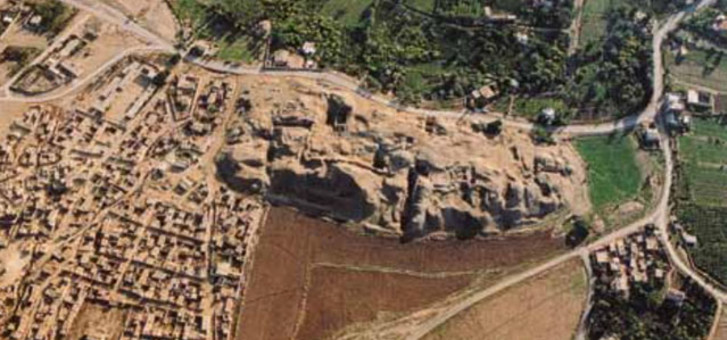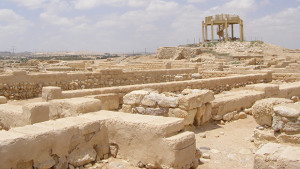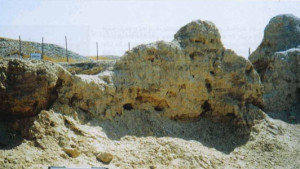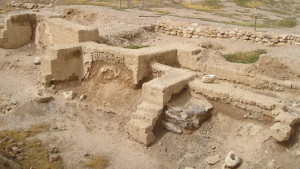There is nothing in the Bible that has come under so much criticism by mainstream archaeologists than the story of Joshua and the conquest of Jericho. Here is the ultimate evidence that the biblical records are historically unreliable. The latest scornful assault came from an article by Ronald S Hendel in the March 2009 edition of Biblical Archaeology Review. Hendel assumes that the Joshua story was written a lot later than the Israelite occupation of Canaan, and that it has been confused with myths about cyclopean walls built by giants. He concludes by saying, “When the walls came tumbling down- well, that must have been a great story” (p 66).
Yes, it was a great story and worth retelling as it is recorded in Joshua 6.
Now Joshua had commanded the people, saying, “You shall not shout or make any noise with your voice, nor shall a word proceed out of your mouth, until the day I say to you, ‘Shout!’ Then you shall shout.” So he had the ark of the Lord circle the city, going around it once. Then they came into the camp and lodged in the camp.
And Joshua rose early in the morning, and the priests took up the ark of the Lord. Then seven priests bearing seven trumpets of rams’ horns before the ark of the Lord went on continually and blew with the trumpets. And the armed men went before them. But the rear guard came after the ark of the Lord, while the priests continued blowing the trumpets. And the second day they marched around the city once and returned to the camp. So they did six days.
But it came to pass on the seventh day that they rose early, about the dawning of the day, and marched around he city seven times in the same manner. On that day only they marched around the city seven times. And the seventh time it happened, when the priests blew the trumpets, that Joshua said to the people: “Shout, for the Lord has given you the city!" So the people shouted when the priests blew the trumpets. And it happened when the people heard the sound of the trumpet, and the people shouted with a great shout, that the wall fell down flat. Then the people went up into the city, every man straight before him, and they took the city. And they utterly destroyed all that was in the city, both man and woman, young and old, ox and sheep and donkey, with the edge of the sword. But they burned the city and all that was in it with fire.
Now there are several features of this story that have come under attack. Why all this apparently senseless ritual of going round the city for six days with no sound but the blowing of the rams’ horns trumpets? How could a whole army march around a city seven times in one day? Why would a loving God decree the slaughter of men, women and children? And the crowning argument is the archaeological evidence that it just did not happen. Jericho was a deserted ruins when the Israelites arrived.
I do not think the silent march around the city is so senseless. I think it was good psychology. By the time the seventh day dawned the men of Jericho must have been a bundle of nerves, an easy prey for the Israelite soldiers that swarmed over the fallen walls.
Marching round the city seven times in one day was no problem. Jericho was only 350 metres in length and 150 metres in width. Jericho was an important city, but cities in those days were only for sleeping in. Work in the daytime was done in the surrounding fields.
Quite frankly, I do not like the idea of the slaughter of men, women and children, but if it happened, we just have to accept it. We do not know all the circumstances involved, and it was not the first time mass destruction had occurred.
God destroyed the entire world - men, women and children in the universal deluge in the days of Noah. There was also mass destruction in Sodom and Gomorrah, and Jesus Christ warned of an impending judgment day when, “He will also say to those on the left hand, ‘Depart from Me, you cursed,
into the everlasting fire prepared for the devil and his angels” (Matthew 25:40).
As for the archaeological evidence, it baffles me that archaeologists choose to ignore the obvious explanation.
Professor John Garstang excavated Jericho from 1930 to 1936. He found walls that had toppled over and much evidence that the city had been deliberately and systematically burned with fire. He attributed this to the Late Bronze Period which most archaeologists assigned to the time of the Israelite invasion.
However, Dr Kathleen Kenyon conducted further excavations in Jericho from 1952 to 1956. She concluded that Garstang had made a mistake and that the walls had fallen at the end of the Early Bronze Period, at least six hundred years earlier, and that the city was only a deserted ruins when Joshua arrived.
But the dates usually assigned to the archaeological periods in Israel have been based on synchronisms with the dynasties of Egypt. Some recent scholars have claimed that there has been a mistake in the dates assigned to these dynasties and they need to be drastically reduced.
Lord Colin Renfrew, top archaeologist in Cambridge University, wrote an introduction to the book Centuries in Darkness written by Peter James, in which he said, “This disquieting book draws attention, in a penetrating and original way, to a crucial period in world history, and to the very shaky nature of the dating, the whole chronological framework, upon which our current interpretations rest ... The revolutionary suggestion is made here that the existing chronologies for that crucial phase in human history are in error by several centuries, and that, in consequence, history will have to be rewritten ... I feel that their critical analysis is right, and that a chronological revolution is on its way" (p XIV to XVI).
If the conquest of Jericho is to be attributed, by a revised chronology, to the end of the Early Bronze Age, the evidence Kenyon found is certainly very consistent with the biblical record. She wrote, “The final end of the early Bronze Age civilization came with catastrophic completeness. The last of the Early Bronze Age walls of Jericho was built in a great hurry, using old and broken bricks, and was probably not completed when it was destroyed by fire. Little or none of the town inside the walls has survived subsequent denudation, but it was probably completely destroyed, for all the finds show that there was an absolute break, and that a new people took the place of the earlier inhabitants. Every town in Palestine that has so far been investigated shows the same break. The newcomers were nomads, not interested in town life, and they so completely drove out or absorbed the old population, perhaps already weakened and decadent, that all traces of the Early Bronze Age civilization disappeared" (Archaeology in the Holy Land, p 134).
“An absolute break ... a new people... every town in Palestine ... newcomers were nomads ... completely drove out or absorbed the old population ...” Could we expect to find a more apt description of the Israelite invasion, nomads from the desert who initially were not interested in living in the cities?
The conquest of Jericho is more than just a good story. When the archaeological evidence is correctly interpreted it can be seen as historically reliable.






